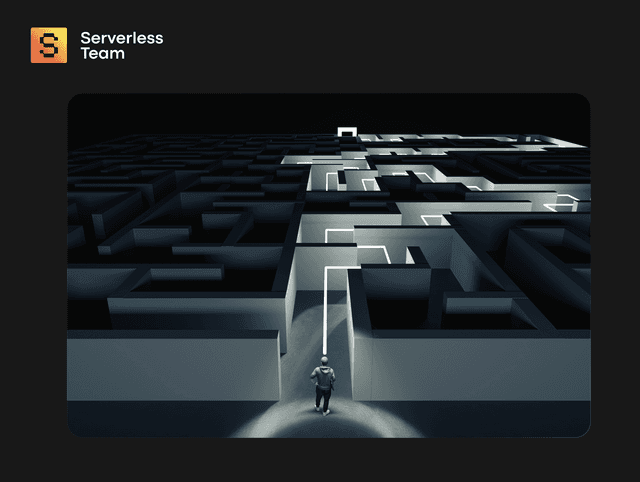Between 2022 and 2027, the investments in data centers will grow yearly by over 15%. Given this market boom, choosing between serverless and monolith architecture has never been more critical. We at Serverless will make your decision smoother, dwelling on our 10-year background and providing a detailed overview of both solutions.
But why is picking the right architecture so crucial? It directly influences how you maintain your project and defines its scalability limits. It also impacts your costs and resources, ultimately affecting your overall success.
Explore even more insights into serverless and traditional architecture in today’s post. Get ready to make a well-judged choice as we explain the features, pros, cons, and differences between these two.

We take care of serverless development so you can focus on your business
Don't want to wait for our site launch? Let's talk about your idea right now.


Serverless Framework vs. Monolith Architecture: A Brief Definition
Let’s start our serverless vs. monolith architecture comparison by getting these two concepts straight.
- Serverless architecture: Serverless computing, despite its name, does involve servers. But it also implies that developers don’t have to manage those themselves. The devs can concentrate on writing code while the service providers set up, maintain, and scale servers based on demand.
- Monolith architecture: Compared to serverless architecture, monolith is a traditional approach that uses physical servers. It puts the whole application together as a single, interconnected piece with a shared code and database. It simplifies development and debugging yet poses scaling and maintenance limitations.
Overall, serverless architecture offers effective resource allocation, automatic scaling, and pay-as-you-go pricing. Monolith, in turn, simplifies the development and testing processes.

Kyrylo Kozak
CEO, Co-founderGet your project estimation!

Features and Capabilities of Serverless and Monolith Architecture
Choosing a suitable architecture is hardly possible without grasping the core features of each. Compare serverless and monolith by their capabilities:
| Features of Serverless and Monolith Architecture | ||
|---|---|---|
| Features | Serverless Architecture | Monolith Architecture |
| Costs | Offers a pay-as-you-go model where charges are based on the number of executed functions. | Involves upfront infrastructure costs with maintenance and scaling expenses. |
| Integrations | Allows for easy integration with various services and APIs, offering a granular system. | Enables third-party services, yet dependencies between components may complicate integration. |
| Multiple environments | Allows to set up several environments easily. | Setting up multiple environments can be complex and resource-consuming. |
| Timeout | Functions must be usually executed within specific time limits. | Offers more flexibility in execution time. |
| Scalability | Provides granular scalability and allows functions to scale independently following demand. | Requires the entire application to scale as a unit and needs careful planning and resources. |
| Maintenance | Maintenance is handled by third-party cloud service providers like AWS, Azure, and others. | Maintenance is covered by the actual user of the architecture. |
We can summarize the distinctive features of serverless vs. traditional architecture this way. Serverless offers granular scaling, event-driven design, and usage-based pricing, while monolith comes with a simple and coherent structure, centralized database, and streamlined development process.
Serverless vs. Monolith: Pros and Cons
Let’s continue exploring serverless and monolith architecture by reviewing their pros and cons. Knowing those will help you make the best choice for your development needs.
Pros and Cons of Serverless Architecture
First, take a look at the pros and cons of serverless architecture. The advantages of this solution include:
- Cost-effectiveness: You only pay for the executed functions and computing resources required.
- Lower operational expenses: You don’t need to set up and maintain your own infrastructure.
- Scalability: You can expand your operations whenever necessary.
- Faster deployment: You speed up coding and testing and relieve your devs from the burdens of server maintenance.
Yet, serverless architecture has its drawbacks. Here are the main ones:
- Cold start issues: Functions may experience latency when invoked after a long inactivity.
- Complex debugging: Debugging may be more challenging since functions are invoked and destroyed on demand.
- Vendor lock-in: Connecting your app to a particular cloud provider may later cause difficulties during migration.
Pros and Cons of Monolith Architecture
The advantages of traditional architecture are:
- Simplicity: You leverage a single codebase and database.
- Effortless debugging and testing: You can find and fix bugs more easily, owing to the unified app structure.
- Predictable scaling: You scale a whole application and fully control this process.
- Centralized database: You can manage data more simply since everything is in one place.
Here are the limitations you may deal with when opting for monolith architecture:
- Limited flexibility: Changing one part of the app may drag broader updates along.
- Resource usage: Scaling traditional architecture requires significant resources and costs.
- Maintenance challenges: Your staff needs to maintain the monolith manually, and it’s especially complex as your app scales.
Monolithic vs. Serverless Architecture: Performance Comparison
Discover another difference between serverless and monolith — their performance. See how each architecture handles varying workloads and consider their response times and latency.
Serverless goes the extra mile by allowing individual processes to scale as necessary. Whenever your workloads shift, you send more requests to the serverless system and trigger the required functions. Response times are blazing-fast for active functions, but there might be latency or a so-called “cold start” when invoking one after inactivity.
Monolith systems, on the other hand, scale as a whole. While this way of scaling is predictable and fully managed, it may leave you with unused computing resources during non-peak periods. On top of that, this architecture generally experiences lower latency and faster response times since its components are tightly integrated.
Read about two popular options for adopting serverless tech in our article on Serverless Framework vs. AWS SAM.
Serverless vs. Monolith: Flexibility and Adaptability
Serverless and monolith architectures bring various degrees of flexibility. Here’s how these solutions accommodate changes and updates:
- Serverless: This architecture is inherently flexible and adaptable. It’s particularly evident in individual functions or microservices. Developers can update certain parts of the app without changing the whole system.
- Monolith: While pretty straightforward in use, this solution has certain limitations in flexibility. If you introduce changes to one part of your system, these alterations further impact your entire app.
You may also be interested in our guide on Serverless vs. Microservices.
Cost Considerations in Serverless and Monolith
The cost of using serverless vs. traditional server is an important consideration. Here are several things to think about when deciding on a suitable architecture for your project.
Serverless architecture offers the following:
- You can pay only for those resources and functions that you actually use.
- You can leverage resources wisely and scale during peak periods or traffic spikes.
- You don’t need to spend extra costs on infrastructure maintenance.
Monolith architecture, in turn, goes with the following financial considerations:
- You need to allocate a certain amount of costs in advance to build your infrastructure.
- You spend extra costs whenever you need to scale.
- You cover all the maintenance expenses.
Once reviewing the above price-influencing factors, it may seem evident that serverless architecture is cost-efficient. But is it? Monolith is perfect for small-scale projects and may even turn out as a more reasonable investment. Thus, while serverless brings significant cost savings, studying your specific project requirements is still crucial.
Key Differences between Serverless Architecture and Monolith Architecture
Having explored almost all serverless and monolith architecture characteristics, it’s time to recap what’s been said. Let’s look at the main differences between these two approaches:
- Scalability: Serverless provides effortless on-demand scaling, while monolith requires significant effort to expand.
- Flexibility: Serverless is highly flexible, though monolith architecture offers simple development and testing.
- Maintenance: Serverless systems are maintained by third-party vendors, while monolith demands manual updates.
- Debugging: Monolith offers easier debugging and testing than serverless architecture.
- Costs: Serverless works on pay-per-use pricing; monolith fully depends on your resources.
What to Choose Between Serverless and Monolith Architecture
What do you choose: serverless or monolith architecture? And how do you make sure your decision is right? Explore the following factors to consider:
- Project scale: Determine your requirements before deciding on architecture. Choose serverless if you deal with large projects and shifting workloads, or opt for monolith if your project has simpler infrastructure needs.
- Team size and expertise: Monolith is easy to operate on and fits smaller teams perfectly. Serverless is a way to go if your experts specialize in distributed systems and event-driven architectures.
- Flexibility requirements: Pick serverless if your project demands high flexibility and frequent updates, and monolith when you deal with predictable workloads.
- Budget constraints: Determine how much you’re ready to spend on the architecture. Serverless is typically more cost-effective, but monolith is reasonable for small-scale projects.
Our Team as Your Serverless Consulting Partner
If you choose serverless architecture for your project, our team can walk you through all the peculiarities of this tech. We’ve been doing this for over ten years, having successfully assisted more than 200 clients worldwide.
Our hands-on experience in serverless and monolith architecture is especially evident in our collaboration with MasterStream, a US-based telecom organization. Our team has helped this client migrate from an outdated monolithic platform to a serverless solution. We leveraged the AWS Lambda-based backend to ensure the desired flexibility and scalability. Our efforts resulted in saved costs, on-demand resource allocation, and improved platform performance.
Want more insights into our work? Explore our portfolio and the latest Serverless vs. Docker containers comparison.
Conclusion
Serverless vs. monolith — what’s your ultimate choice? Both architectures offer undeniable benefits like flexibility and scalability of serverless and simplicity and centralization of the monolith. Yet, before making your decision, consider your project’s unique requirements.
If you decide to choose the serverless structure, rely on our team for expert guidance and smooth implementation. Contact us today to access agile, performant, and scalable solutions.





